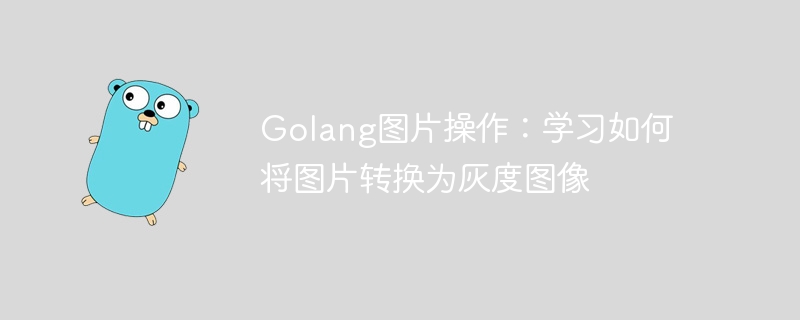

Golang Image Manipulation: Learn How to Convert Pictures to Grayscale Images
In the field of computer vision and image processing, converting color images to grayscale images is a Common tasks. Grayscale images use only brightness information to represent an image, regardless of color. In this article, I will show you how to use Golang for image manipulation to convert color images into grayscale images.
First, we need to import the necessary packages. In Golang, we can use the image and image/color packages to process images.
package main
import (
"fmt"
"image"
"image/color"
"image/jpeg"
"os"
)Next, we need to open the color image file we want to convert. We can use the os.Open function to open the file and the jpeg.Decode function to decode the JPEG image file.
func main() {
// 打开彩色图像文件
file, err := os.Open("color_image.jpg")
if err != nil {
fmt.Println(err)
return
}
defer file.Close()
// 解码JPEG图像文件
img, err := jpeg.Decode(file)
if err != nil {
fmt.Println(err)
return
}
}Now, we have successfully opened and decoded the color image file. Next, we will create a new grayscale image and copy the brightness information from the color image into the grayscale image.
// 创建一个灰度图像,与彩色图像具有相同的尺寸
grayImg := image.NewGray(img.Bounds())
rect := img.Bounds()
for y := rect.Min.Y; y < rect.Max.Y; y++ {
for x := rect.Min.X; x < rect.Max.X; x++ {
// 获取该像素的颜色信息
color := img.At(x, y)
// 将彩色像素转换为亮度
grayColor := color.Gray()
// 在灰度图像中设置相同的像素值
grayImg.Set(x, y, grayColor)
}
}In the above code, we first create a new grayscale image grayImg with the same dimensions as the color image. We then loop through each pixel of the color image, get the color information for that pixel, and convert it to brightness using the color.Gray() function. Finally, we use the grayImg.Set() function to set the same pixel value in the grayscale image.
The last step is to save the converted grayscale image. We can create a new image file using the os.Create function and save the grayscale image as a JPEG image file using the jpeg.Encode function.
// 创建一个新的图像文件
outFile, err := os.Create("gray_image.jpg")
if err != nil {
fmt.Println(err)
return
}
defer outFile.Close()
// 将灰度图像保存为JPEG图像文件
err = jpeg.Encode(outFile, grayImg, nil)
if err != nil {
fmt.Println(err)
return
}
fmt.Println("转换成功!")
}In the above code, we create a new file outFile and use the jpeg.Encode function to convert the grayscale image grayImg Save as JPEG image file. Note that on the last line, we print a message to confirm whether the conversion was successful.
Now you can run the complete code above and convert the color image file color_image.jpg to a grayscale image gray_image.jpg.
In this article, we learned how to use Golang for image manipulation and convert color images into grayscale images. By using the image and image/color packages, we opened the color image file, created a new grayscale image, copied the brightness information of the color image into the grayscale image, The converted grayscale image was then saved.
I hope this article will be helpful to your learning in image processing. In practical applications, you can further explore other technologies and methods of image processing, such as image enhancement, edge detection, etc.
The above is the detailed content of Golang Image Manipulation: Learn how to convert a picture to grayscale. For more information, please follow other related articles on the PHP Chinese website!
 How to modify the text in the picture
How to modify the text in the picture
 What to do if the embedded image is not displayed completely
What to do if the embedded image is not displayed completely
 How to define variables in golang
How to define variables in golang
 What are the data conversion methods in golang?
What are the data conversion methods in golang?
 What are the commonly used libraries in golang?
What are the commonly used libraries in golang?
 What is the difference between golang and python
What is the difference between golang and python
 How to make ppt pictures appear one by one
How to make ppt pictures appear one by one
 How to make a round picture in ppt
How to make a round picture in ppt




